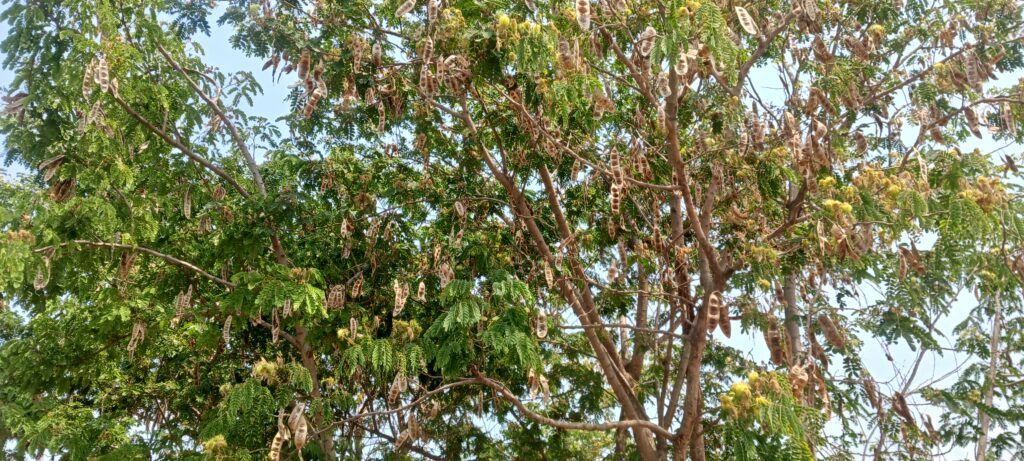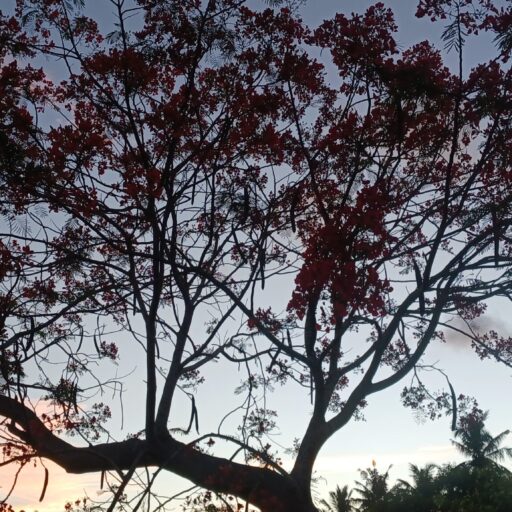Introduction

Albizia lebbeck is a medium to large, fast-growing deciduous tree known for its broad crown and lush, fern like foliage. The tree has spreading canopy with broad umbrella-like shape. The plant is commonly planted in garden as a shade tree and is a natural way to prevent soil erosion due to its shallow roots. This plant grows best in warm areas with hardiness zone 10-11. It is widely cultivated worldwide for its wood, shade and ornamental value. It can reach a height of 18meter with 10 year from seed. Albizia lebbeck is a species cultivated as a shade tree in North and South America. In India and Pakistan, the tree is used to produce timber. It is also a great plant to grow if you wish to attract bees to the garden. It grows into big tree usually found in roadside of southern India. Leaves fall in winter, valuable shade is provided during the heat of summer. Establishing tree are drought tolerant and do not require excess watering. Beyond its medicinal use Indian Sirisa has cultural importance in many communities. In India, the tree is associated with lord Krishna and often planted near temple.
Native
It is native to the Indian subcontinent and part of southeast Asia. Indian Sirisa is native to a wide range of regions, including India, Sri Lanka, Bangladesh and various Southeast Asian countries. It thrives in tropical and Subtropical Climate.
Common name
Sirisa, Indian Sirisa, East Indian Walnut, Broome raintree, Lebbeck, Lebbeck tree, Fry wood, Koko, and woman tongue tree, saras, Sirisala, Khok.
Tree height
It is a tree growing to a height of 18-30m tall with a trunk 50cm to 1m diameter.
Stem
The bark of the tree is dark grey to brown and is deeply fissured, giving it a distinctive appearance.
Leaves
The leaves are bipinnate leaves, meaning each leaf is divided into multiple smaller leaflets. The leaflets are small oblong and about 3-6cm in length.
Flower
The flowers are small, fragrant and typically cream white to pale yellow in color. The flowers are white, with numerous 2.5-3.8cm long stamens and very fragrant. They are arranged in globular clusters and have long stamens that extend beyond the petals giving them a unique appearance. Flowers are bisexual greenish yellow in color Blooming in Spring. This produces fragrant, yellowish white flowers followed by long, flat seed pods that rattle the wind.
Fruit
The fruit is a pod 15-30cm long and 21.5-5.0cm Broad, containing 6-12 seeds. The fruit of Albizia lebbeck is a long, flat straight pod like structure. These pods are woody and brown when mature, containing several seeds.
Seeds
The seeds are brown, flat and either orbicular or elliptic in shape. The seeds are transverse arranged with 6-12 seeds per pod. They measure approximately 8-10mm in diameter horizontally and 6-7mm vertically with each pod.
Seed is harvested manually. As with many legumes, there is no need to wait until pods are dry to harvest seed. Pods are mature when they have turned light yellow and should be harvestedwhen the last patches of green are disappearing. It is important that collection is not delayed as insects can very quickly infest mature pods. Seed is extracted by beating or in a flail thresher. After extraction the seed is dried directly in the sunlight . Once sufficiently dried, seed should be stored heremetically.
Habitat
The Albizia lebbeck commonly known as the Sirisa tree, thrives in diverse habitat across tropical and subtropical regions. It can succeed in degraded or nutritional poor soils. The tree tolerant wide range of temperature from 120C to 480C.
Soil preference
It grows best in loamy, sandy soil that are well drained and slightly acidic, but it can tolerate a more neutral or alkaline Soils. it prefers pH range 6-7, tolerating 5.5-8.5.
Watering
Indian Sirisa require regular watering especially during its early growth stage. It can tolerate moderate drought but does not do well in water logged soil.
Sun requirement
It requires full sunlight to grow while it prefers a more humid environment. It can thrive in drier areas with proper care. Albizia lebbeck thrives in full sunlight and can tolerate partial shade. It prefers direct sunlight for the major of the days.
Pruning
Pruning is done to shape the tree and removed dead or damaged branches. It is advisable to prune during the dormant season to encourage vigorous growth in the following Spring.
Propagation
It can be propagated from seeds. Collect fresh seeds from matured Indian Sirisa pods. Which are contained within it’s pods. The seeds should be dark brown or black with no cracks or holes. Sirisa plant can be grown efficiently from seed and only required to be soaked in boiling water for up to three minute to enhance germination. Another method is Soak them in water overnight to help soften the hard seed coat and aid germination. Sow the Albizia lebbeck seeds directly in the soil. When the seeds reach about 4-6 inches apart. This will give the remaining seedling enough room to grow and mature. Once the seedling are about 6-12 inches tall and have several sets of leave, you can transplant them to their permanent location in your garden. It can also propagate through cutting. Indian Sirisa prefers a well-draining soil mix that is rich in organic matter. Seedling will not tolerate frost, but trees are moderately frost resistant when established.
General uses
Its wood is valued for its quality and used in carpentry and furniture making. The wood obtained from Indian Sirisa is utilized in construction activities and tool making. It is an excellent fuel wood species with a caloric value of 5200kcal/g.
Medicinal use
It is an important Anti poisoning herb of Ayurveda. Its use is even indicated in snake bite poisoning. This plant has extensively recommended to neutralize toxin in the body. It has also been used in the treatment of affliction like bronchial asthma. Based on various experimental and clinical observation use of Sirisa bark in the form of a herbal tea for asthmatic persons has been recommended. Such use help to control the frequency and intensity of the asthmatic attack.
It is a versatile and esteemed medicinal plant with a rich history of traditional use. it’s numerous health benefit make it valuable resources in natural medicine. It has a long history of medicinal and cultural significance in the region where it grows. The bark of Indian Sirisa is employed for medicinal proposes, providing remedies for various elements.
Toxicity
There is no widespread evidence of toxicity in Albizia lebbeck to human, dog or cat.
Pests and diseases
Albizia lebbeck is relatively pest and disease resistant. But scale insects, termites and leaf spots can affect them. Regular inspection and removal of affected plants parts and organic pest and diseases control method can help prevent and manage these issues.
Chemical constituent
Indian Sirisa is rich in bioactive compound that contribute to its medicinal properties like Alkaloids, Flavonids, Saponins, tannis, glycocides, terpenoids, phenolic compounds, protein and Amino Acids. Sirisa contain things called flavonoids, tannis and glycocides that calm inflammation, block allergy chemicals, mop up cell damaging free radicals that trigger diseases and influence neurotransmitter activity to ease anxiety. On top of that, the other elements in Sirisa activate your body’s natural defender against germs and infections.
Classification
Kingdom -Plantae, Phylum-Angiosperm, Class-Magnoliopsida, Family-Fabaceae, Genus- Albizia lebbeck
Far (Frequently asked question)
- In India Sirisa safe for long term uses?
- Long term use of Indian Sirisa should be monitored, especially regarding potential effects on liver health. Consult a healthcare provider for guidance.
- Can Indian Sirisa be used for anxiety and depression?
- Indian Sirisa has shown promise in managing anxiety and depression but consult a healthcare provider for personalized advice.
- Can Indian Sirisa be used as a sleep aid?
- Indian Sirisa may help improve sleep quality and manage insomnia, but dosages and individual’s response vary.
- Is there ongoing research on Indian Sirisa?
- Yes, ongoing research continue to explore the medicinal properties and potential applications of Indian Sirisa including its impact on various health condition.
- Does Indian Sirisa have any reported case of adverse reaction?
- Some individuals may experience allergic reaction, digestive discomfort or central nervous system effect when using Indian Sirisa. If adverse reaction occurs discontinue use.
- Is Indian Sirisa suitable for children and the elderly?
- It is best to consult a health care professional before using Indian Sirisa with children or the elderly, and doses should be adjusted based on age and weight.
- What does Sirisa taste and smell like?
- Sirisa bark and flower have a mildly bitter, astringent taste resembling green tea. Its scent is often described as rich and faintly resinous.
